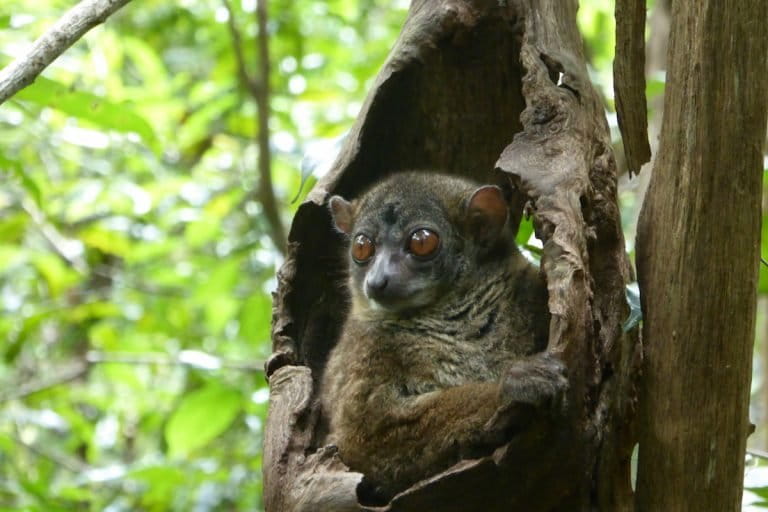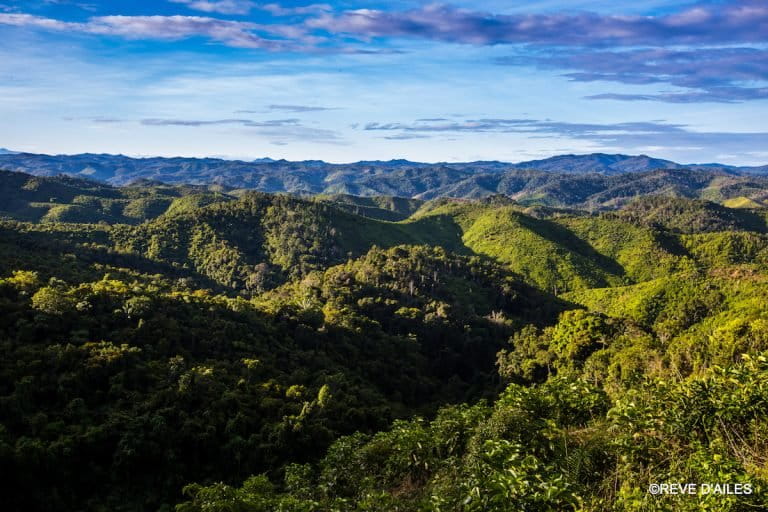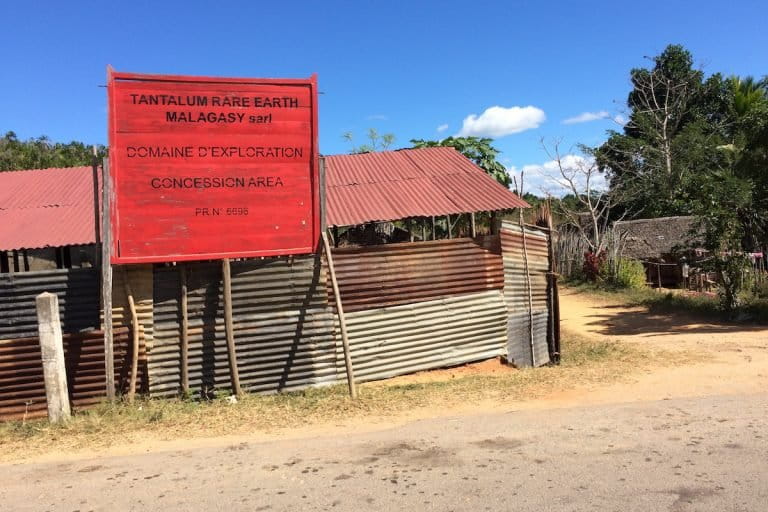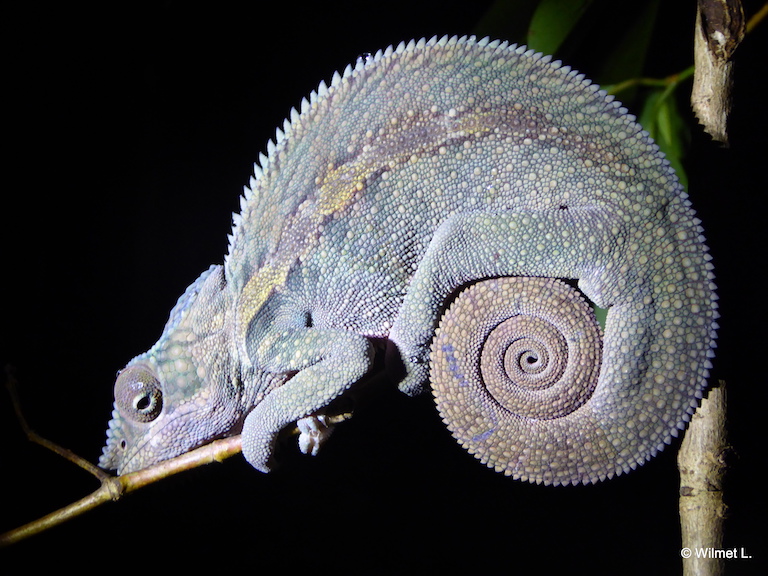- German and Singaporean business interests have been attempting to start a rare earth mine on northwestern Madagascar’s Ampasindava peninsula.
- According to some scientists, going forward with the project would pose grave long-term threats to local people and the surrounding rainforest, including a protected area home to endangered lemurs and other unique wildlife.
- The project has been beset by ownership uncertainty, an ongoing investigation into one of its owners for financial misconduct, and permit delays.
- Now its concession, previously valued at over $1 billion, has been reappraised at just $48 million.
A rare earth mining project in Madagascar that has been in turmoil for the last two years took another blow in September, when its concession, previously valued at over $1 billion, was reappraised at just $48 million. Tantalum Rare Earth Malagasy (TREM), a company owned by firms in Germany and Singapore, holds the rights to the 92-square mile (238-square kilometer) concession, located on the Ampasindava peninsula in northwest Madagascar, just across the water from Nosy Be, the country’s main tourist destination.
Demand for rare earth elements, sometimes called “technology metals,” has risen in recent decades because they are used in the production of smartphones and other modern devices. China dominates the market for rare earths, having produced more than 85 percent of world supply for the last few decades. But the environmental and health impacts of rare earth mining have caused Chinese authorities to restructure the industry and close, or attempt to close, many of the mines. Now investors are looking elsewhere.
TREM’s project would be the first rare earth mine in Madagascar. For now, the project has stalled due to a lack of permits and unstable ownership. According to some scientists, going forward with the project would pose grave long-term threats to local people, who oppose the project, and to the surrounding rainforest, including a protected area home to endangered lemurs and other unique wildlife.
“It will be a nightmare for anything living there — humans, animals, or plants,” a geologist familiar with ionic clay rare earth mining told Mongabay. “It will be a huge disaster. It will destroy the whole peninsula,” added the geologist, who asked not to be named due to the sensitive nature of the situation.


Potential impact
The rare earth deposit in Ampasindava is of an uncommon type known as ionic or ion-adsorption clay. Most similar deposits are near Ganzhou in southeast China, although they make up less than 3 percent of China’s total rare earth reserves. Unlike other rare earth deposits, ionic clay does not contain high levels of the radioactive elements uranium and thorium. However, mining ionic clay still causes extreme environmental and health consequences.
TREM has not yet decided which mining method it would use in Ampasindava. It is considering three techniques: heap leaching, vat leaching, and in-situ leaching. The first two would involve open-pit mining of the ground’s surface. When these techniques have been used on ionic clay mines in China, the results have been dire for local ecosystems. For every ton of rare earth oxide extracted, 300 square meters of vegetation and topsoil are removed, 2,000 tons of tailings are disposed in nearby valleys or streams, and 1,000 tons of highly polluted wastewater is created, according to a 2013 paper by Chinese researchers.
“[S]urface/mountaintop mining for ion-adsorption rare earth ores has become the dominant driver of land-use change and degradation in southern China, causing permanent loss of ecosystem, severe soil erosion, air pollution, biodiversity loss and human health problems,” the authors write.
There are hundreds of millions of tons of tailings from ionic clay mines in the Ganzhou area, and the environmental costs, measured strictly by how much it costs to restore the land, exceed the revenues produced by the rare earths, the Chinese state press has acknowledged.
In fact, if the project goes forward, TREM may not have any choice but to use an open-pit mining technique on most of the concession, according to the geologist familiar with ionic clay mining. The alternative, ostensibly safer in-situ method requires ground that is flat and porous, which is uncommon in ionic clay deposits.
Even if the in-situ leaching method is used, it may not prove much better for the environment. In-situ leaching does not involve highly disruptive surface mining, but it does require huge amounts of ammonium sulfate solution to be pumped into the ground with great force. Rare earth oxides then trickle through the ground to a collection trench — thus the need for porous earth. This method, if not applied with care, can lead to water contamination, mine collapses, and landslides.
Water contamination could spell trouble not just for public health but for the local economy. The streams in TREM’s mining concession serve as the water source for cash crops such as cacao, pepper, coffee, and vanilla. Thus far, no environmental impact study of the project has been completed, so it is difficult to know how severe the effects, both onsite and downstream, could be.
Some scientists working on the peninsula have expressed concern about the project. If it goes forward, the mine is likely to reduce the habitat of the Endangered Mittermeier sportive lemur (Lepilemur mittermeieri), which lives only on the peninsula, Leslie Wilmet, a doctoral student in conservation biology at the University of Liège and Gembloux Agro-Bio Tech in Belgium who studies the lemurs, told Mongabay in August. “The problem with the TREM project will be that lots of forests will disappear,” she said at the time. “We don’t know if the species will survive or not if the project goes on.”


Shaky underpinnings
Delays in the TREM project are due not so much to environmental concerns as to management setbacks. ISR Capital, a Singapore-listed firm trying to take a majority stake in TREM, is under investigation for financial misconduct. The company has been linked to John Soh Chee Wen, who currently faces charges for some of the worst financial crimes in Singapore’s history. David Rigoll, a high-flying UK-based investor and ISR’s largest shareholder used to be a leading shareholder and executive at Tantalus Rare Earth AG (TRE AG), the German firm that has owned TREM since 2009. (Rigoll himself has previously been caught up in a stock scandal.)
TRE AG poured over $30 million into the Madagascar project, its sole holding, but ran out of funds and filed for bankruptcy in 2015. In a two-part deal, it sold TREM to REO Magnetic, a private company in Singapore. In September of this year, the second part of the deal, for the remaining 40 percent of TREM, was canceled. TRE AG now retains that 40-percent ownership of TREM; a recent filing indicates that it might still try to sell the stake.
On paper, the other 60 percent is owned by REO Magnetic, but ISR Capital made a deal to buy this stake from REO over a year ago. The Singapore stock exchange has not yet approved the deal; last year, the exchange refused to accept two appraisals commissioned by ISR, each of which valued the “Madagascar asset” at over $1 billion. Behre Dolbear Australia (BDA), the North Sydney-based consultancy ISR commissioned for the latest appraisal, referred to the two previous appraisals as of “limited credibility,” and to their methodologies as “quite inappropriate” and in “direct contradiction” of industry standards.
Although the new appraisal indicates that TREM is worth less than 5 percent of previous estimates, in making it BDA relied on assumptions that Mongabay’s previous reporting suggests may not bear out. The valuation assumes that new permits for exploration and pilot testing are forthcoming. Yet TREM currently has no permit of any kind; the company’s exploration permit expired in January and although it applied for a permit renewal last December, the government has yet to issue one nearly a year later. Also, BDA acknowledges in the report that it did not review any environmental studies and did not conduct an independent social assessment. That is, BDA apparently did not speak to people in Ampasindava. The report cites only TREM’s opinion of what those people think, casting them as supportive of the project; in reality, many locals strongly oppose it.
And while BDA is qualified and respected in the field, it’s unclear if it has any experience with ionic clay rare earth mines — few people outside of China do. (Queried by Mongabay about its experience in this specific field, BDA declined to comment.)
In addition to the concession’s devaluation, ISR Capital faces other challenges in moving the project forward. This week, ISR’s stock price dropped to an all-time low, which could make fundraising for the project difficult, especially since ionic clay mining is a specialized field in which ISR has no experience. In fact, as a company, ISR has no track record whatsoever in the mining industry, as the BDA report acknowledges.
ISR, REO, TRE AG, TREM, and the prime minister’s office in Madagascar did not respond to requests for comment.
Timeline: Singapore’s investigation of ISR Capital
[EXPAND] The ownership of Tantalum Rare Earth Malagasy (TREM), the company exploring for rare earth elements in northwest Madagascar, has been in flux since late 2015. ISR Capital, a Singapore-listed company, is in the process of taking a majority stake in TREM. In 2016, just before the announcement of its TREM acquisition, ISR’s stock price began a dramatic rise that lasted several months. When it later crashed, the Singapore stock exchange suspended trading of ISR stock. Singapore authorities connected ISR to an alleged mastermind of stock manipulation, and opened an investigation into the company.
December 8, 2015: Tantalus Rare Earth (TRE AG), a German company that had owned TREM since 2009, agrees to sell TREM to a private Singapore-registered company now known as REO Magnetic in a two-part deal. ISR Capital does not yet have anything to do with TREM.
May 9, 2016: David Rigoll, a U.K.-based mining investor, enters into an agreement to buy more than a quarter of the shares of ISR Capital and a few days later joins the company as a director. Rigoll had until recently been an executive and leading shareholder of TRE AG.
May 12, 2016: The Singapore stock exchange, observing an unusual increase in the trading of ISR Capital stock that could be a sign of insider trading or stock manipulation, asks the company if any information — about, for example, possible impending acquisitions — needs to be made public. ISR Capital replies “no.”
May 19, 2016: ISR Capital’s share price has now increased by more than 700 percent in the ten-day period since Rigoll signed on.
May 20, 2016: ISR Capital announces a deal to purchase an as-yet undefined stake in TREM from REO Magnetic. After further negotiations, the agreement entails ISR purchasing a 60 percent stake in TREM for about $30 million, roughly seven times the price that REO had paid to TRE AG for the same stake a few months earlier. The Singapore stock exchange later questions ISR’s methodology in making the purchase at this price. (If both this deal and the two-part deal between TRE AG and REO were to go through, ISR would ultimately own 60 percent of TREM and REO would own the remaining 40 percent.)
July 16, 2016: In a filing, ISR Capital writes that TREM is applying for a pilot production permit. Madagascar’s National Environmental Office (NEO) gave TREM permission to conduct an environmental impact study, which the company must submit for approval before the NEO will issue a pilot production permit. No study has been turned in at press time, more than a year later, according to the NEO.
August 14, 2016: ISR Capital acknowledges that Timothy Morrison, an executive at the advisory firm that ISR had hired for help with the TREM acquisition, was also a director of REO Magnetic, the company selling TREM. ISR had failed to disclose this information until regulators asked specifically about Morrison. This was a potential conflict of interest that may have allowed Morrison to sit on both sides of the table during the ISR/REO negotiations. ISR explains that when it conducted its records search on REO, Morrison was not yet a director there.
In the same communication, the stock exchange asked ISR Capital about a potential conflict of interest linked to David Rigoll’s involvement with both TRE-AG and ISR Capital. In response, ISR writes that Rigoll’s investments in the two companies did not overlap.
September 2016: TRE AG hands over management of TREM to REO Magnetic, now the majority owner of TREM, according to Markus Kivimäki, TRE AG’s CEO.
September 29, 2016: With its stock price soaring, ISR Capital announces that it will loan TREM about $4.5 million. ISR is investing in the Ampasindava project even though its deal to acquire the 60 percent stake in TREM from REO Magnetic has not yet been finalized.
November 2016: ISR Capital’s share price has now increased by more than 4,000 percent since April.
November 8, 2016: In response to a regulator’s inquiry, ISR Capital explains that it has loaned TREM money so that it can obtain environmental permits, which are critical to the project’s success. TREM needs $7.1 million to get environmental permits, ISR explains.
ISR states: “…there are no significant risks to the Permits not being approved as [TREM] has addressed all 147 items highlighted by the National Environment Office in the scope of work submitted earlier this year. [TREM] expects to obtain the Permits in Q1 of 2017.”
When showed this ISR filing, the National Environment Office’s environmental evaluation director wrote to Mongabay that he was “unaware of this.” At press time TREM has not received the pilot production permits. In fact, TREM no longer has even an active exploration permit. ISR does not appear to have revealed the lack of permits to investors or regulators.
November 21, 2016: The Singapore stock exchange questions ISR Capital’s two valuations of the “Madagascar Asset” in Ampasindava. Both consultants valued the concession at over $1 billion. However, the Singapore stock exchange rejected both valuations for failing to meet the exchange’s standards: the first was done by an unqualified sole proprietor, while the second copied some data from the first, without making a site visit to Ampasindava.
The first valuation, by Geologica Pty Ltd, which was quickly promoted by ISR upon its completion in July 2016, discounted local opposition and environmental risk. “The potential land tenure risk, including Native Title risk is considered low, as is the sovereign risk associated with the concession,” the appraiser wrote. After a perfunctory look at potential environmental impacts, he added, “Geologica concludes that there is a low environmental risk associated with the concession.”
November 24 and 25, 2016: Jon Soh Chee Wen, alleged mastermind of the penny-stock crash of 2013, is arrested and charged for his role in what Singapore authorities call “the largest market manipulation case in Singapore’s history.” ISR Capital is a penny stock — a high-risk stock investment that can be purchased cheaply — with connections to the 2013 scandal, and its price begins to plummet, losing more than half of its value in a day. Three days later, the Singapore stock exchange suspends trading of ISR stock.
December 7, 2016: To investigate a potential violation of Singapore’s Securities and Futures Act, authorities demand copies of all of ISR Capital’s recent emails, meeting minutes, and merger deals.
December 20, 2016: Singapore prosecutors confirm connections between ISR Capital and Jon Soh Chee Wen. They also announce that they are investigating ISR Capital. Eventually they will claim in a court document that Soh “was intimately involved in, and exercised influence over, the management and corporate affairs of ISR.” (Contacted by Mongabay in August, the Monetary Authority of Singapore declined to comment on the status or nature of the investigation.)
March 6, 2017: After more than three months of suspension, the Singapore stock exchange relists ISR Capital after issuing a “trade with caution” warning. The stock plummets once more, and David Rigoll sells a significant portion of his shares. Rigoll also resigns as an executive director, criticizing management and becoming at least the fourth high-level ISR executive to resign in as many months.
March 2017: TRE AG retakes operational control of TREM, on a temporary basis, due to what Kivimäki referred to as “certain challenges at the buyer.”
April 28, 2017: ISR Capital confirms that it will move forward with the TREM acquisition.
August 1, 2017: ISR Capital and REO Magnetic agree to new terms. Instead of paying $30 million for the 60 percent stake in TREM, ISR will now pay about $3.3 million. ISR is still awaiting a third appraisal of the Ampasindava concession.
August 6, 2017: ISR Capital admits that the Ampasindava concession has a much lower value than the two earlier appraisals suggested. In the same document, ISR explains that “there have been limited exploration activities by the Operating Company [TREM] in the past months.” ISR again fails to mention that TREM has had no exploration permit since January. TREM staff in Ambanja told Mongabay there had been no exploration this year.
September 21, 2017: TRE AG announces that the second part of its deal with REO, for the remaining 40 percent of TREM, has been canceled.
September 22, 2017: Behre Dolbear Australia releases a new appraisal, commissioned by ISR Capital, that gives the Ampasindava concession a most likely value of $48 million, less than 5 percent of the previous estimates.
November 16, 2017: David Rigoll, who until this week still owned about 17 percent of ISR Capital, sold most of his remaining shares. He now owns about 3 percent of the company.
An unknown species of chameleon that resides on the Ampasindava peninsula. Photo by Leslie Wilmet.
Banner image: An endangered Sambirano mouse lemur (Microcebus sambiranensis), which is found only in two or three small populations in northwest Madagascar, including one on the Ampasindava peninsula. Photo by Leslie Wilmet.
Citations
Yang, X.J., & Lin, A., Li, X-L., Wu, Y., Zhou, W., Chen, Z. (2013). China’s ion-adsorption rare earth resources, mining consequences and preservation. Environmental Development 8 131(6).

FEEDBACK: Use this form to send a message to the editor of this post. If you want to post a public comment, you can do that at the bottom of the page.

